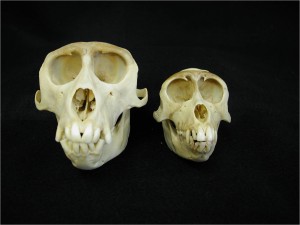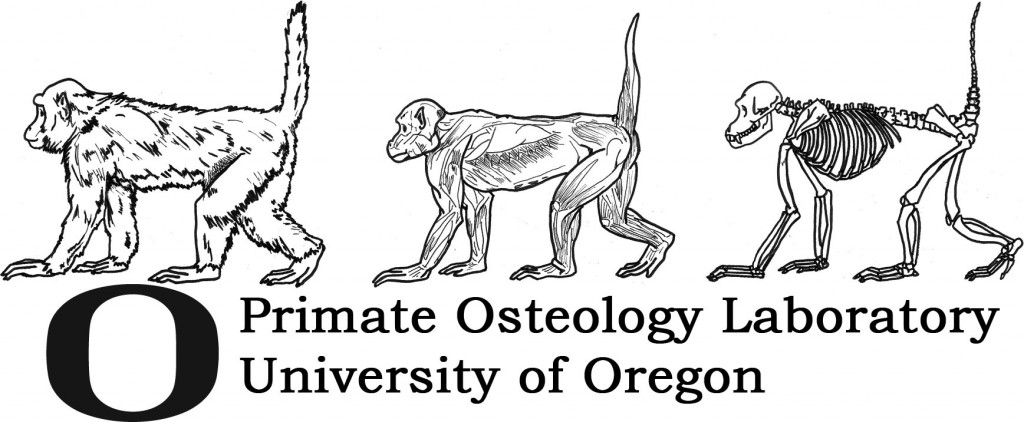The Primate Osteology Lab (Condon 304) at the University of Oregon houses the Museum of Natural and Cultural History‘s UO Comparative Primate Collection, also known as the “Grand Collection” named after its most important contributor (anatomist Dr. Theodore I. Grand, now at the National Zoo in Washington, DC). The Grand Collection houses over 700 primate and 125 non-primate vertebrate skeletal specimens (example photos). The primates consist mostly of Old World monkeys, but there are numerous Prosimians and New World monkeys as well. The non-primate collection includes a wide variety of placental and marsupial mammals (predominantly carnivores, insectivores, and rodents) from sloths to bats as well as a varied collection of birds, reptiles, amphibians, and fish.
 Many specimens in the collection were assembled by Dr. Grand from captive, experimental, and natural contexts between 1963 and 1982 during his tenure at the Oregon National Primate Research Center. As a result, associated life history data (age, sex, cause of death, body weight, gestation length, and genealogical information) are available for most of the specimens, with an emphasis on macaques. Such data rarely accompany primate skeletal collections and permit the investigation of many scientific problems that: 1) require relating variables of the living specimen (tissue weights, body weight, demographic factors) to skeletal variables, or 2) require knowledge of genealogical history to investigate a trait’s heritability. In addition to traditional studies of primate skeletal and dental morphology, this collection offers the potential for unique research projects focusing on allometry, growth and development, and patterns of inheritance among primates.
Many specimens in the collection were assembled by Dr. Grand from captive, experimental, and natural contexts between 1963 and 1982 during his tenure at the Oregon National Primate Research Center. As a result, associated life history data (age, sex, cause of death, body weight, gestation length, and genealogical information) are available for most of the specimens, with an emphasis on macaques. Such data rarely accompany primate skeletal collections and permit the investigation of many scientific problems that: 1) require relating variables of the living specimen (tissue weights, body weight, demographic factors) to skeletal variables, or 2) require knowledge of genealogical history to investigate a trait’s heritability. In addition to traditional studies of primate skeletal and dental morphology, this collection offers the potential for unique research projects focusing on allometry, growth and development, and patterns of inheritance among primates.
| The collection is open and available to all researchers. The current Excel database of the primate and non-primate species and specimens can be downloaded using the following link: MNCH Grand Osteology Collection. Contact Dr. Frances White to discuss or schedule a research visit. |
Since 2010 (when the Grand Collection moved to its new space) more than a dozen students have received credit hours performing over 800 labor hours to restore the Grand Collection. Our goal is to create a well-documented and accessible collection of non-human primate skeletal material that will be available for use in research and teaching. This is especially useful because the western US is relatively impoverished in such collections compared to other parts of the country. Working on the Grand Collection renovation and in the Primate Osteology Lab is an invaluable learning experience: “…my favorite part about the lab is the cohesiveness of the staff and the opportunities I have gotten because of it. Without the primate osteology lab…course [work] would have been at least 3 times more difficult. I have learned more about bone morphology and pathology in the last term than I have in my entire life, and I find that to be invaluable, especially considering my future career in this field.” -from a student volunteer.
Professor Frances White, Curator of the MNCH Comparative Primate Collection, and her undergraduate and graduate students work closely with the Zooarchaeology Laboratory managed by Professor Madonna Moss and the Primate Morphometrics Laboratory, coordinated by Professor Stephen Frost, which has facilities for several types of morphometric techniques and analysis. Students learn curatorial maintenance and to prepare, clean, sort, identify, catalogue and measure specimens in the Grand Collection.
These opportunities provide students with hands-on experiences in a biological laboratory and skills relevant to collection management, bone identification, and zoological educational experiences. “I really enjoyed the one on one time I got with the lab instructors…I found this particularly helpful in my learning and expansion of knowledge. I think the lab and atmosphere is wonderful and broadens learning to a degree not achieved in a normal classroom…this lab was an amazing experience that I feel very fortunate to have been a part of.”- from a student volunteer.
Students can then go on to be involved in team research projects, to present posters at the UO Undergraduate Symposium, present at national meetings of the AAPA or ASP, and complete honors projects or receive academic credit.
For more information on the Grand Collection, including access for researchers, please contact Dr. Frances White.






